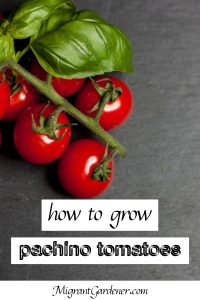How do you grow the Sicilian Pachino tomato?
(Note that it’s not easy to get your hands on Pachino tomato seeds. Hence, I’ve limited the write-up because it’s not so easy to find out info about the plant’s growing habits for best fruit performance.)
The Sicilians and the Italians say it as “pomodoro di Pachino” (Pachino tomatoes).
With its PGI (Protected Geographical Indication) label, which it obtained in 2013, the Pachino tomato plant comes in three different varieties: Cherry (“ciliegino”), larger round variety, and ribbed (“costoluto”). The cherry Pachino tomato is the best known.
Pachino tomato plant (and tomato) facts for growers
The plant is indeterminate, meaning, it has some vigor to its growth habit.
The tomatoes have a mid-season maturity.
The tomatoes are of a sweet flavor and pinky-red in color.
Pachino tomatoes, because of the official designation, are only grown in the Pachino region of Sicily. However, if you manage to get your hands on Pachino tomato plant seeds, you can grow them wherever you are in the world.
Best way to eat Pachino tomatoes

Do as the Italians (or, rather, Sicilians) do – toss your Pachino tomatoes into a pan and add garlic, chili pepper, and olive oil. Then, serve up with pasta.
On the other hand, Pachino tomatoes are great to eat fresh.
Sicilians also love to consume Pachino tomatoes as “confit.”
What’s confit? Or how to make confit? Place your Pachino tomatoes onto an oven tray; lightly sprinkle with salt, pepper, a little sugar, fresh herbs, and drizzle with olive oil.
Cook at 284 F (120 C) for a couple of hours. Consume either hot or cold. Or, preserve in olive oil in sealed jars. Or, add to pasta-based dishes.

